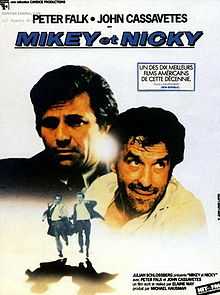Mikey and Nicky
| Mikey and Nicky | |
|---|---|
 | |
| Directed by | Elaine May |
| Produced by | Michael Hausman |
| Written by | Elaine May |
| Starring |
Peter Falk John Cassavetes Ned Beatty Rose Arrick Carol Grace Reuben Greene |
| Music by | John Strauss |
| Cinematography |
Bernie Abramson Lucien Ballard Victor J. Kemper |
| Editing by |
John Carter Sheldon Kahn |
| Distributed by | Paramount Pictures |
| Release dates | December 21, 1976 |
| Running time |
119 min. (Canada:106 min.) |
| Country |
|
| Language | English |
| Budget | $4.3 m |
Mikey and Nicky is a 1976 film written and directed by Elaine May. Using three cameras that she sometimes left running for hours, May captured spontaneous interaction between Peter Falk and John Cassavetes. This unusual technique and the resulting performances exceed the conventions of the gangster movie.
Mikey and Nicky was released in New York City on December 21, 1976. The film was originally intended as a summer 1976 release, then moved to Christmas 1976 due to editing problems.
May missed the film's delivery date by almost a year because of her well-known perfectionism in the editing process. Litigation followed between the director and Paramount, with Paramount gaining possession of the film with final cut privilege. May didn't direct again for nearly 12 years.
The film's original $1.8 million budget had grown to nearly $4.3 million ($16.6 million in contemporary dollars[ 1]) by the time May turned the film over to Paramount. She shot 1.4 million feet of film, almost three times as much as was shot for Gone with the Wind. At one point, Cassavetes and Falk had both left the set and the cameras remained rolling for several minutes. A new camera operator said "Cut!" only to be immediately rebuked by May for usurping what is traditionally a director's command. He protested that the two actors had left the set. "Yes", replied May, "but they might come back".[1]
Angered by May's contentiousness during filming and editing, Paramount booked the completed film into theaters for a few days to satisfy contractual obligations, but did not give the film its full support. A new version of the film—approved by May—was shown at the Museum of Modern Art in New York City for the Directors Guild of America Fiftieth Anniversary Tribute on November 17, 1986.
The film was also shown at the United States Film Festival in Park City, Utah ("Tribute to John Cassavetes"), on January 25, 1989.
May originally cast Paramount president Frank Yablans as a gangster, but Charles Bluhdorn, the chairman of parent company Gulf+Western, was not amused, and demanded that she recast.
Synopsis
When Nicky calls Mikey yet again to bail him out of trouble—this time a contract on his life for money he stole from his mob boss—Mikey, as always, shows up to help. Overcoming the obstacles of Nicky's paranoia and blind fear, Mikey gets him out of the hotel where he has holed up, and starts to help him plan his escape, but Nicky keeps changing the plan, and a hit man is hot on their trail. As they try to make their escape, the two friends have to confront issues of betrayal, regret, and the value of friendship versus self-preservation.
Cast
- Peter Falk .... Mikey
- John Cassavetes .... Nicky
- Ned Beatty .... Kinney
- Rose Arrick .... Annie
- Carol Grace .... Nellie
- William Hickey .... Sid Fine
- Sanford Meisner .... Dave Resnick
- Joyce Van Patten .... Jan
- M. Emmet Walsh .... Bus Driver
- Sy Travers .... Hotel Clerk
- Peter R. Scoppa .... Counter Man
- Virginia Smith .... Jan's Mother
- Jean Shevlin .... Lady on Bus
- Danny Klein .... Harry
- Martin Wolfson .... Candy Store Man
- Eugene Hobgood .... Mel
- David Pendleton .... Bar Patron
- Will Gill, Jr. .... Bartender
- Marilyn Randall .... Shirley
- Reuben Greene .... Franklyn
References
- ↑ Blum, David (16 March 1987). "The Road to 'Ishtar': How Warren Beatty, Dustin Hoffman and Elaine May Made a Farce in the Desert for Just $40 Million". New York: 42.
External links
- Mikey and Nicky at the Internet Movie Database
- Mikey and Nicky at allmovie
- Mikey and Nicky at Rotten Tomatoes
| |||||